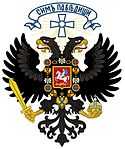Provisional All-Russian Government
| Provisional All-Russian Government | |||||
| Временное Всероссийское правительство | |||||
| |||||
|
| |||||
| Capital | Omsk | ||||
| Languages | Russian | ||||
| Government | Dictatorship | ||||
| Supreme Ruler | Alexander Kolchak | ||||
| Historical era | Russian Civil War | ||||
| - | Established | 3 November 1918 | |||
| - | Disestablished | 14 January 1920 | |||
The Provisional All-Russian Government (PA-RG) was a short-lived government centred in Omsk during the Russian Civil War. It was principally formed from the Komuch, mainly Socialist-Revolutionary Party (SRs) and Constitutional Democratic Party (Kadets) members based in Samara, and the Provisional Siberian Government, which consisted mainly of regional politicians and rightist officers and was based at Omsk. The two regimes had previously failed to work effectively together, being by rivalry including a customs war and numerous border disputes.
A State Conference was held at Ufa between 8–23 September 1918, which resulted in the establishment of this last attempt at a unified anti-Bolshevik government. It encompassed 170 delegates including some from other regions. But the result was a compromise. The Komuch gained recognition for the SR-dominated Constituent Assembly as the eventual basis of power. But they also lost their claim to be the legal All-Russian government. In its place a five-man Directory was set up as the embodiment of the new government: This consisted of two SRs, Nikolai Avksentiev and Vladimir Zenzinov; the other Directors were Vologodsky, a regional politician and head of the Omsk Provisional Siberian Government, General A. G. Boldyrev and the left Kadet Vinogradov. The day-to-day administration of the government was carried out by a Council of Ministers of whom the majority (10 out of 14) were former members of the Provisional Siberian Government.
The PA-RG was vehemently criticised by Viktor Chernov, founder of the Socialist-Revolutionary Party (SR). He declared the Ufa Settlement to be unsatisfactory and that "counter-revolutionary" elements were involved in the new government. He advocated that the party should rally the population behind the Constituent Assembly and organise the People's Army as an independent force. This antagonised the right, who identified the PA-RG with the Provisional Government of Alexander Kerensky
This political crisis was resolved when the Provisional All-Russian Government was overthrown on 17 November 1918. A Cossack detachment arrested Avksentiev and Zenzinov. Next morning Vologodsky called for a PA-RG Council of Ministers. The Directory was dissolved and its former Minister of War, Admiral Kolchak, became Supreme Ruler.
The Supreme Ruler issued the following manifesto to the population:
The Provisional All-Russian Government has come to an end. The Council of Ministers, having all the power in its hands, has invested me, Admiral Alexander Kolchak, with this power. I have accepted this responsibility in the exceptionally difficult circumstances of civil war and complete disorganisation of the country, and I now make it known that I shall follow neither the reactionary path nor the deadly path of party strife. My chief aims are the organisation of a fighting force, the overthrow of Bolshevism, and the establishment of law and order, so that the Russian people may be able to choose a form of government in accordance with its desire and to realise the high ideas of liberty and freedom. I call upon you, citizens, to unite and to sacrifice your all, if necessary, in the struggle with Bolshevism.
The SR leaders in Russia denounced Kolchak and called for him to be killed. Their activities resulted in a small revolt in Omsk on December 22, 1918, which was quickly put down by Cossacks and the Czech Legion, who summarily executed almost 500 rebels. The SRs opened negotiations with the Bolsheviks and in January 1919 the remnants of the Komuch's People's Army joined the Red Army.
References
- Evan Mawdsley, The Russian Civil War (2008). Edinburgh, Birlinn, pp. 143–8.
External links
- Russian government documents
- Search Official Russian government documents, including historic ones
- The Provisional Government at historylearningsite.co.uk.
